Oct 04, 2011
Turbulence hits EU airline pollution scheme
SPPI Blog - The Financial Times
Source: Financial Times
By Andrew Parker in London
Airlines face being caught up in a global trade war as opposition grows to the European Unionís controversial plan to make carriers pay for their pollution, the aviation industryís main representative body warned on Monday.
Tony Tyler, director-general of the International Air Transport Association, told the Financial Times there was a genuine risk that countries outside the EU would take retaliatory action against the bloc’s plan to bring airlines within its carbon emissions trading scheme from January.
On Thursday, an advocate general to the European Court of Justice will issue an opinion on a request by US airlines for non-European carriers to be excluded from the EU scheme. This should give a steer on the subsequent ruling by the ECJ, which the European Commission is confident will side with the EU rather than the US airlines.
Last Friday, 21 countries including the US, Japan, Brazil, Russia, India and China issued a declaration opposing how the EU scheme will apply to flights that start or end in one of the blocís 27-member states. They say the scheme was inconsistent with international law and should not apply to flights by non-EU carriers.
Mr Tyler said he feared retaliatory measures against European airlines by countries outside the EU if the US carriers lose their court case.
“That is the worst possible outcome for us - the airlines being caught in the middle of a trade war,” said Mr Tyler. “Other countries saying to Europe ‘OK, if you are hitting our airlines with additional cost, which you should not be doing, we will hit your airlines’ - none of us wants that.’
He also noted that China, partly in protest at the EU scheme, threatened in June to derail a deal under which Hong Kong Airlines would order 10 superjumbo A380 aircraft from Airbus, a subsidiary of EADS, the European aerospace and defence group.
Mr Tyler said the EU should abandon its plan to bring airlines within its emissions trading scheme, adding the issue should be tackled through a global industry framework devised by the International Civil Aviation Organisation, a UN agency.
Iata estimates airlines face a bill of at least $26bn to comply with the EU scheme over the next decade. Under the scheme, airlines will have to surrender permits, each equal to one tonne of carbon dioxide, to cover their annual emissions. A portion of the permits will be allocated to airlines free of charge but heavy polluters will have to buy additional ones.
A spokesman for Connie Hedegaard, the European climate change commissioner, said the EU scheme was consistent with international law, adding the bloc was willing to engage with countries that had concerns about it. The spokesman said ICAO’s member states had been unable to agree on how to tackle the aviation industry’s emissions and, therefore, the EU had decided it was time to act.
Oct 01, 2011
The EPA Gets Caught in a Big Fat Lie
By Alan Caruba
By Alan Caruba
The notion that the Environmental Protection Agency uses “science” to justify their regulations is false, just like most of the claims they issue on various aspects of the nation’s environment. Their favorite scam is to estimate the number of deaths they will prevent with some new draconian regulation.
The EPA is the American equivalent of the Gestapo, a ruthless enforcement agency with a very Green agenda that is opposed to the use of many beneficial chemicals, every form of energy, and the right of people to be left alone.
At the top of its list of priorities is the destruction of the nationís economy with special attention to all forms of energy production. Manufacturing anything comes next, followed by afflicting the nation’s vast agricultural sector. The EPA insists that dust is a pollutant. You can’t farm without generating DUST.
To understand the threat the EPA poses it is necessary to understand that proposed Clean Air regulations are based on the claim that “global warming” is real, is happening, and is caused primarily by carbon dioxide (CO2). The claim is utterly without any scientific merit.
There is NO global warming. At least not the kind Al Gore lies about.
The North and South Poles are not melting; they gain and lose ice in a perfectly natural cycle that has been going on for billions of years. The polar bears are not disappearing. Drilling for oil in ANWR will have zero effect on the caribou. Et cetera!
With our vast reserves of coal and natural gas, the U.S. does not lack for the ability to generate electricity or to refine oil for transportation.
If you want to stay warm this winter, you better hope that utilities keep producing the electricity for your home or apartment’s heating system. Fifty percent of that electricity is produced by cheap, abundant coal and the EPA is hell bent to shut down as many coal mines as possible, leading in turn to the shutdown of utilities that burn coal. Natural gas accounts for just over twenty-four percent of electricity generation and it need hardly be said that the EPA is wary of fracking, the technology to access it.
Blowing the Whistle on the EPA
The big news - the kind even the mainstream media was unable to ignore - was that the EPA’s own inspector general has released a report accusing the agency of cutting corners regarding the “science” cited to justify its effort to declare CO2 a “pollutant.”
Simply stated, without CO2 all life on Earth dies.
It is a gas that plants use for their growth. From a blade of grass to a giant redwood, all depend on CO2, as do all the crops grown coast to coast. Enormous quantities of corn and wheat are grown that contribute to the U.S. economy, feeding both livestock and humans in wondrous ways. Take away vegetation and the animals die. Take away the animals that grace our dinner plates and we die.
Absurdly, the EPA says it is a “pollutant”, a dangerous hazard to our health.
No, the most dangerous hazard to our health is the EPA.
The EPA insists on ignoring all the other natural sources of CO2 as well as the fact that it constitutes less than one percent, 0.038 percent of the atmosphere. The oceans of the world gather it, store it, and release it. The EPA, though, says that when man is involved, it is pure evil.
Mind you, every human exhales about six pounds of CO2 every day. The fact is that the air Americans inhale daily is clean is due to the agency’s early efforts to mitigate some abuses. Those were the days before the EPA abandoned a rational, fact-based approach to its stated objectives. One of its legacies is the idiotic required inclusion of ethanol in every gallon of gasoline. Made from corn, it actually produces more CO2 to produce and use.
The EPA effort to regulate CO2 came along with the invention of the global warming hoax that claimed CO2 was trapping” the Earth’s heat. That is why CO2 and others are deceptively called “greenhouse” gases (GHGs). Manufacturing everything from a donut to megawatts of electricity emits GHGs.
Finally, even the EPA’s inspector general blew the whistle on the utterly deceitful way the EPA arrives at its justification for a vast matrix of regulations that has been stifling the economy for years. The IG has charged that the EPA did not meet its own guidelines for peer review to ensure the integrity of the science stated.
Anyone who has been following the rise and fall of the global warming hoax knows that “peer review” has become a highly corrupted practice. Real peer review is critical to the integrity of any scientific study. When major science journals abandoned the peer review process to publish gibberish about global warming, they put all other new scientific studies at risk.
As Marlo Lewis, a senior fellow at the Competitive Enterprise Institute, noted, the EPA’s regulation of CO2 emissions would require “230,000 full-time employees to produce 1.4 billion work hours to address the actual increase in permitting functions” that would result if the EPA is allowed to get away with this scandalous hoax. It would cost an estimated $21 billion per year. By contrast, the EPA’s budget request for fiscal year 2012 is $8.973 billion.
The EPA claims that the Clean Air Act gives it the power to regulate CO2, but it does not. It was never intended to, but the Supreme Court in one of its more idiotic rulings opened the door for the EPA claim. In his dissent from Massachusetts v EPA, Justice Antonin Scalia quipped that, as defined by the Court, “everything airborne, from Frisbees to flatulence, qualifies as an ‘air pollutant’”
Sen. John Barrasso (R-WY) pointed out that “The EPA’s determination has led to a mountain of Clean Air Act regulations that could cost over a million jobs.” It is noteworthy that Sen. Barrasso said, “EPA administrator Lisa Jackson has regularly assured Congress and the American public that its finding is based on sound scientific practices.” It isn’t. Jackson “should testify immediately,” said Sen. Barrasso, “the American people deserve the truth.”
The EPA has been short on the truth about all of its claims for four decades and needs to be shut down in order to let a truly science-based agency replace it with strict congressional oversight and limitations.
The time is long overdue to pull the plug on the Environmental Protection Agency.
Sep 29, 2011
Evidence that the sun drives the oceans which control our weather and climate
By Joe D’Aleo, Weatherbell.com co-chief meteorologist
The EPA technical support document proclaimed:
“Most of the observed increase in global average temperatures since the mid-20th century is very likely due to the observed increase in anthropogenic GHG concentrations. Climate model simulations suggest natural forcing alone (e.g., changes in solar irradiance) cannot explain the observed warming.”
That is because they only considered the brightness changes and solar irradiance/brightness changes only 0.1 to 0.15% in the 11 year cycle and perhaps 0.4% since the Little ice Age. They have ignored all the other solar factors like ultraviolet which can change 8-10% in the 11 year cycle and X-rays 100%. Nor did they consider the geomagnetic changes or the solar wind induced changes in cosmic rays which can alter low cloud cover (and albedo or reflectivity) by 1 or 2%. Low clouds reflect sunshine. A quiet sun means less warming from radiation amplified by more cloudiness. Duke’s Nicola Scafetta has estimated the total solar affects (direct and indirect) could explain 60% of the variance of global temperatures. Much of the other might be explained by urbanization and land use changes, He and his research partners found evidence for 60 year cycles in many data sets. The AMO and PDO are about 60-70 year cycles.
This chart comparing the AMO and the total solar irradiance computed by Hoyt/Schatten and Willson using muliple solar components and calibrated to the recent ACRIMSAT satellites is rather convincing for me. It shows a very tight tracking of the AMO with TSI since 1900.
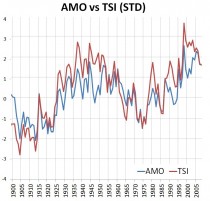
Enlarged
The AMO has a positive correlation most places across the northern hemisphere. This would explain the warmth since 1995. Note most warming is in the northern hemisphere.

Enlarged
You can see the step ladder discontinuity in northern hemisphere temperatures after the AMO flip in 1995. No statistically significant warming is seen in the tropics and southern hemisphere.The positive PDO phase from 1977 to 1998 with its predominance of El Ninos which produce warming had shown a gradual warming.
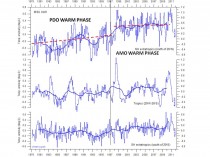
Enlarged
Look at how well the AMO correlates with the arctic temperatures.
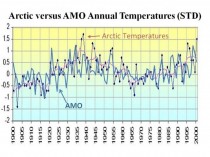
Enlarged
Add to the oceans and solar, the effects of volcanism - big volcanoes with cooling and quiet periods with warming and you can pretty much explain the observed changes despite the ‘models’. This also includes the arctic. Note next the cooling with high stratospheric aerosols and warming from low.
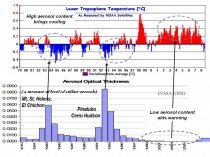
Enlarged
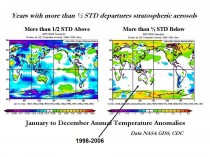
Enlarged
Bringing it full circle and you have the sun tying nicely with arctic temperatures (after Soon).
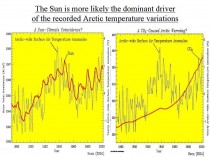
Enlarged
What does this mean for upcoming years/decades? Well if indeed the next few solar cycles harken back to the Dalton Minimum in the early 1800s, we can expect the Atlantic AMO to cool and global and arctic temperatures to decline. Throw in more volcanoes and winters will become even more memorable. We seem to be already on our way.
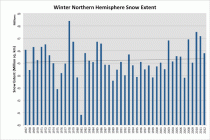
Enlarged
Also note the trend towards cold winters in the US the last decade.
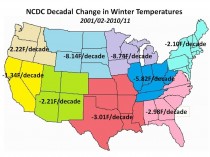
Enlarged
Join us on Weatherbell.com.
http://icecap.us/images/uploads/GLOBAL_UAH_vs_PDO_AMO.jpg
Sep 28, 2011
Global warming: New study challenges carbon benchmark
By AFP
First be sure to check out the excellent detective work that shows how Gore faked the CO2 experiment in the “Video analysis and scene replication suggests that Al Gore’s Climate Reality Project fabricated their Climate 101 video ”Simple Experiment” on WUWT. Kudos to Anthony and and the Gang.
Here is the Scripps study:
--------------------
PARIS - The ability of forests, plants and soil to suck carbon dioxide (CO2) from the air has been under-estimated, according to a study on Wednesday that challenges a benchmark for calculating the greenhouse-gas problem.
Like the sea, the land is a carbon “sink”, or sponge, helping to absorb heat-trapping CO2 disgorged by the burning of fossil fuels.
A conventional estimate is that soil and vegetation take in roughly 120 billion tonnes, or gigatonnes, of carbon each year through the natural process of photosynthesis.
The new study, published in the science journal Nature, says the uptake could be 25-45 percent higher, to 150-175 gigatonnes per year.
But relatively little of this extra carbon is likely to be stored permanently in the plant, say the researchers. Instead, it is likely to re-enter the atmosphere through plant respiration.
This will be a disappointment for those looking for some good news in the fight against climate change.
The more carbon is sequestered in the land, the less carbon enters the atmosphere, where it helps to trap heat from the Sun.
Lead researcher Lisa Welp, of the Scripps Institution of Oceanography in the University of California at San Diego, said figuring out the annual carbon uptake from the terrestrial biosphere had been one of the biggest problems in the emissions equation.
Scientists, though, were confident about current estimates for carbon sequestration in land and this was unlikely to change much in the light of the new findings, she said.
“More CO2 is passing through plants (than thought), not that it actually stays there very long,” she said in email exchange with AFP.
“The extra CO2 taken up as photosynthesis is most likely returned right back to the atmosphere via respiration.”
The research looked at isotopes, or variations, in the oxygen component of CO2, using a databank of atmospheric sampling going back three decades.
These isotopes are a chemical tag, indicating the kind of water the molecule has come into contact with.
The researchers looked at isotopes whose concentrations are linked to rainfall.
They were struck by a clear association between these isotopes and El Nino, the weather cycle which occurs in pendulum swings every few years or so.
The implication from this is that CO2 is swiftly cycled through land ecosystems, the researchers suggest. From that assumption comes the far higher estimate of annual carbon uptake.
Sep 26, 2011
If we stay on with business as usual, the southern U.S. will become almost uninhabitable
Tom Nelson Blogspot
Warmist James Hansen: “If we stay on with business as usual, the southern U.S. will become almost uninhabitable”
Worldwide climate day of action hits streets of NYC | NYU’s Daily Student Newspaper
The event featured key members of the environmental advocacy community, including NASA climate scientist Dr. James Hansen, GRITtv founder Laura Flanders and Mohammed Waheed Hassan, vice president of the Maldives.
Hansen, 70, who in 1998 was the first person to testify before Congress about global warming, warned the crowd of the dangers of inaction.
“Climate change - human-made global warming - is happening,” he said. “It is already having noticeable impacts. ... If we stay on with business as usual, the southern U.S. will become almost uninhabitable.”
Storms of My Grandchildren: The Truth About the Coming Climate Catastrophe and Our Last Chance to Save Humanity, by James Hansen
When the history of the climate crisis is written, Hansen will be seen as the scientist with the most powerful and consistent voice calling for intelligent action to preserve our planet’s environment.
- Al Gore, Time Magazine
Actually here is the annual temperature plot from 1895 to 2010 for the southern US (TX, OK, MS, AR, KS) from NOAA NCDC even after the removed adjustments for urbanization growth which enhanced apparent warming.

|












